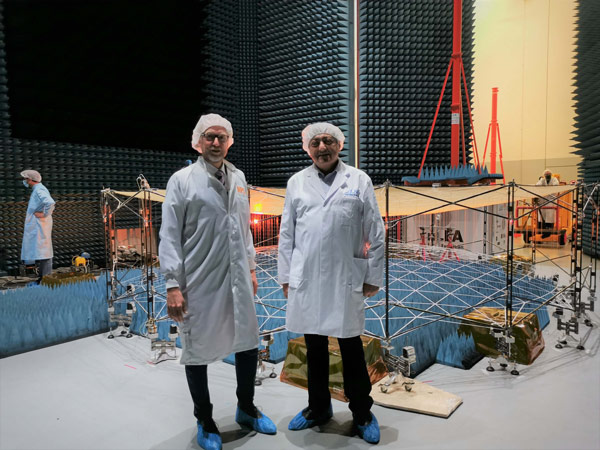Noveber 2020
Quad successful premiere for Europe’s non-dependence in space
Deployable 5-meter “LEA” antenna starts baptism of fire on the test stand
Punctually three years after the decision of the EU, in November 2017, to place the development of the critical space technology of an antenna that can be deployed in space in the hands of an SME-consortium with 15 companies from seven member states led by the Munich-based antenna specialist HPS, the project celebrated four successful European premieres on November 10th 2020:
- Installation of a 5m deployable reflector of and by LSS GmbH
- First surface accuracy check of this reflector
- First RF (Radio-Frequency) test of the complete reflector
- First successful application of highly innovative RF-test technology.
The space programs of ESA and the EU reflect the enormous importance of research and application projects from earth observation and telecommunications for the development of independent ecological and economic positions in politics and business.

The first prerequisite for this is the unrestricted availability of the communication capabilities and image data collection of corresponding satellites – and thus of their antennas. In order to save weight and storage, more and more deployable constructions are being planned here, which have so far only been available in the USA. Europe has now put a stop to this dependence.
The 5-meter antenna (now under test) under the designation “LEA-X5”, is intended for X-band communication. The surface accuracy of the reflector, developed since the beginning and assembled now by LSS for many months, was measured by HPS with laser radar technology from NIKON. The element of the antenna responsible for the reflection, the gold plated metal mesh under the designation “ESM-European Space MESH”, is also compatible with the higher Ku-band. It is manufactured by HPTEX, a joint venture of HPS and Iprotex in cooperation with Fraunhofer in Münchberg. The high-precision carbon fiber struts were developed by the Portuguese company “FHP”, while unfolding electronics were supplied by the Schwetzingen Company “von Hoerner & Sulger”.
Also the adherence to all interlinked corridors of the participants all over Europe to realize this early test date was successful despite considerable organizational complications caused by the Covid-19 pandemic: “operative flexibility in teamworking, technical genius and the unconditional will to succeed – these are the decisive factors especially in these times. And the WeLEA example shows once again: These are medium-sized companies,” says HPS CEO Pfeiffer. And the CEO of LSS, Leri Datashvili adds: “it has been a very hard work of the LSS team after having collected all the needed components and materials from partners to have designed and built a 5 m large deployable reflector in a very short time reaching the high quality of the RF surface shape, which is now ready for the RF tests”
Now the reflector will be characterized in several frequency ranges (C to Ka-Band) from Airbus over the next 3 weeks in Ottobrunn. Special ground support mechanisms from the Portuguese company INEGI ensure that the reflector is positioned horizontally. The prediction of the antenna performance was carried out by the Danish company TICRA with the help of their special RF software GRASP, with geometrical data from LSS simulations.
In the next step, not only the reflector, also the deployable arm of the antenna will be tested environmentally at INTA in Spain; the focus will be on compliance with vibration, shock and thermal vacuum requirements. Beginning next year intensive deployment tests will follow finally. The entire test campaign will be concluded with PFM (proto-flight model) status in March 2021.
In parallel, WeLEA is already working on an 8-meter Ka-band capable engineering model “LEA-K8r” (reflector and arm) in contract to ESA, as preparation for the technical realization of the polar cap mission CIMR (Copernicus Imaging Microwave Radiometer), which will help Europe to gain its own and politically unbiased picture of the status of climate change. The first deployment tests are planned here for the first quarter 2021.
About WeLEA:
The European SME dominated „WeLEA“-SME-consortium consists of the following European space companies: HPS (prime contractor, DE), LSS (main partner for the reflector, DE), RUAG (DE), FHP (PT), vH&S (DE), Luma (SE), Invent (DE), HPtex (DE), ARQUIMEA (SP), etamax (DE), TICRA (DK), WSS (DE), Inegi (PT), INTA (SP), ONERA (FR). The consortium is strengthened in the H2020-LEA-X5 project on system- and test-side by OHB (DE), TAS (FR) and Airbus (DE).
